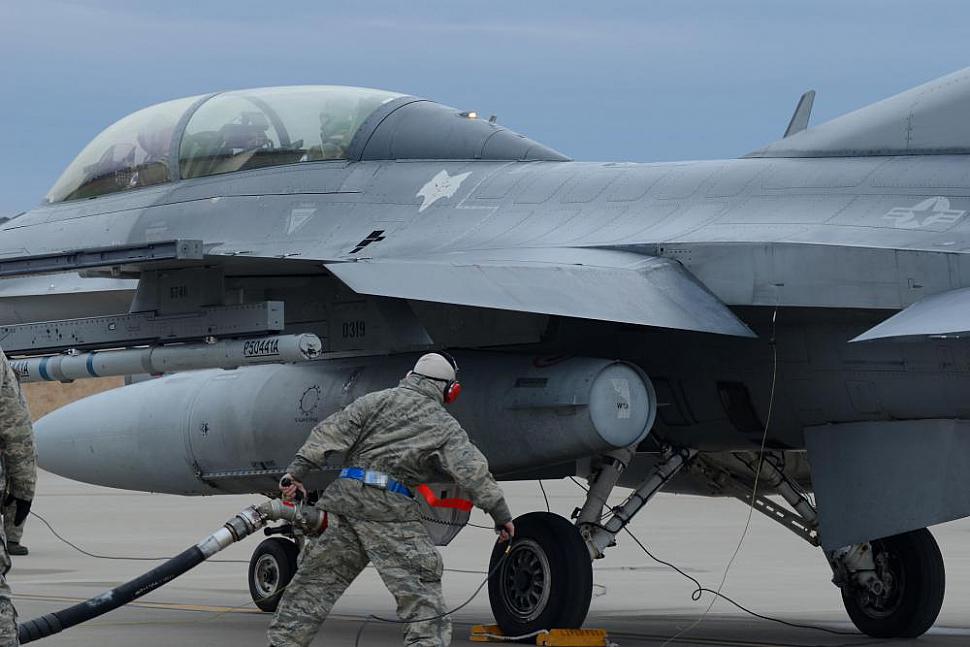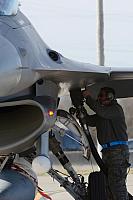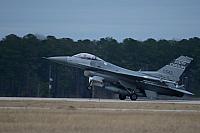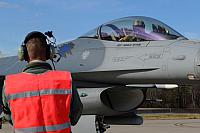Fighter Jet News
F-16 Fighting Falcon News
F-16s fast-track through flight line fueling
February 16, 2016 (by
SrA Ashleigh Pavelek) -
Airmen of the South Carolina Air National Guard demonstrated the need for speed last weekend as they accelerated six F-16 Fighting Falcon fighter jets through “hot-pit” ground refueling exercises at McEntire Joint National Guard Base, S.C., Feb. 6-7.

Keeping the F-16’s engines running reduces the amount of time the jet is on the ground between flights from almost two hours to less than 45 minutes.
“If the jets shut down, then maintenance checks have to be done. This can take hours to complete,” said Maj. Justin Mock, chief of weapons and tactics and a pilot assigned to the 157th Fighter Squadron. “Refueling the jets while the engines are running allows us to save time by not having to do these checks.”
Pilots at McEntire are required to fly six sorties per month. Hot-pit training qualifies the pilot for two sorties to reach their monthly goal; one sortie for each takeoff and mission flown.
The fighter jets taxied to the North Ramp of the flight line, where crew chiefs directed the pilots into position, connected the fuel hose and began fueling within minutes of the jet’s arrival. The fueling process took approximately 10 minutes per jet and they were in and out of the pit in less than 30 minutes.
“Each F-16 receives between 800 and 900 gallons of fuel in the hot-pit,” said Senior Airman Emily Bocinski, a fuels specialist assigned to the 169th Logistics Readiness Squadron.
The R-11 Mobile Refueling Unit, fuel truck, arrived to the hot-pit, hauling its maximum capacity of fuel. Each truck can carry nearly 6,000 gallons, and distributed more than 4,500 gallons into the fuel tanks of the fighter jets. If necessary, the pumps are powerful enough to dispense 600 gallons per minute into a military aircraft.
Fueling an F-16 while the engine is running presents new hazards to the mission.
“Hot-pit refueling is more dangerous than a normal refueling because the intakes and exhausts are running, so knowing the safety zones are critical,” Senior Master Sgt. Mark Tanner, the B-Flight superintendent assigned to the 169th Aircraft Maintenance Squadron.
One of the greatest risks of this mission is a person or object being drawn into the intake, Bocinski said. Foreign Object Debris, FOD, such as stones or equipment, may get drawn into the intake causing minor blade damage or it can destroy the entire aircraft engine.
“The blades of the engine spin at an incredible rate. If a wrench gets ingested into an intake, it can cause catastrophic damage,” said Tanner.
To ensure safety and procedure compliance during the exercise, a quality assurance inspector was present. The base has been performing hot-pit refueling exercise since 2007.

USAF SrA. Jeremy Jimenez, a crew chief assigned to the 169th Aircraft Maintenance Squadron of the South Carolina Air National Guard, connects a fuel hose to an F-16 during 'hot-pit' ground refueling training on the flight line at McEntire JNGB on February 7th, 2016. Ground refueling while the engine is running allows aircraft to return to flight quickly during sortie operations and combat missions. [ANG photo by SrA. Ashleigh S. Pavelek]
“If the jets shut down, then maintenance checks have to be done. This can take hours to complete,” said Maj. Justin Mock, chief of weapons and tactics and a pilot assigned to the 157th Fighter Squadron. “Refueling the jets while the engines are running allows us to save time by not having to do these checks.”
Pilots at McEntire are required to fly six sorties per month. Hot-pit training qualifies the pilot for two sorties to reach their monthly goal; one sortie for each takeoff and mission flown.
The fighter jets taxied to the North Ramp of the flight line, where crew chiefs directed the pilots into position, connected the fuel hose and began fueling within minutes of the jet’s arrival. The fueling process took approximately 10 minutes per jet and they were in and out of the pit in less than 30 minutes.
“Each F-16 receives between 800 and 900 gallons of fuel in the hot-pit,” said Senior Airman Emily Bocinski, a fuels specialist assigned to the 169th Logistics Readiness Squadron.
The R-11 Mobile Refueling Unit, fuel truck, arrived to the hot-pit, hauling its maximum capacity of fuel. Each truck can carry nearly 6,000 gallons, and distributed more than 4,500 gallons into the fuel tanks of the fighter jets. If necessary, the pumps are powerful enough to dispense 600 gallons per minute into a military aircraft.
Fueling an F-16 while the engine is running presents new hazards to the mission.
“Hot-pit refueling is more dangerous than a normal refueling because the intakes and exhausts are running, so knowing the safety zones are critical,” Senior Master Sgt. Mark Tanner, the B-Flight superintendent assigned to the 169th Aircraft Maintenance Squadron.
One of the greatest risks of this mission is a person or object being drawn into the intake, Bocinski said. Foreign Object Debris, FOD, such as stones or equipment, may get drawn into the intake causing minor blade damage or it can destroy the entire aircraft engine.
“The blades of the engine spin at an incredible rate. If a wrench gets ingested into an intake, it can cause catastrophic damage,” said Tanner.
To ensure safety and procedure compliance during the exercise, a quality assurance inspector was present. The base has been performing hot-pit refueling exercise since 2007.
Courtesy of 169th Fighter Wing
Additional images:




USAF SrA. Bruce Broom, a crew chief assigned to the 169th Aircraft Maintenance Squadron of the South Carolina Air National Guard, disconnects a fuel hose during 'hot-pit' ground refueling training on the flight line at McEntire JNGB on February 6th, 2016. Ground refueling while the engine is running allows aircraft to return to flight quickly during sortie operations and combat missions. [ANG photo by SrA. Ashleigh S. Pavelek]

USAF F-16C block 52 of the 157th FS lands on the runway to receive fuel during a 'hot-pit' ground refueling exercise at McEntire JNGB on February 7th, 2016. Ground refueling while the engine is running allows aircraft to return to flight quickly during sortie operations and combat missions. [ANG photo by SrA. Ashleigh S. Pavelek]

USAF TSgt. John Moler, a crew chief assigned to the 169th Aircraft Maintenance Squadron of the South Carolina Air National Guard, directs the pilot of an F-16 during 'hot-pit' ground refueling training on the flight line at McEntire JNGBase on February 6th, 2016. Ground refueling while the engine is running allows aircraft to return to flight quickly during sortie operations and combat missions. [ANG photo by SrA. Ashleigh S. Pavelek]
Related articles:
Forum discussion:
Tags
- SCANG pilot posts 4,000 hours (2012-06-08)
- F-22 News: F-22s use refueling 'pit stop' (2007-04-19)
- F-16 Fighting Falcon news archive
Forum discussion:
- Start a discussion about this article in the F-16.net forum.
Tags
